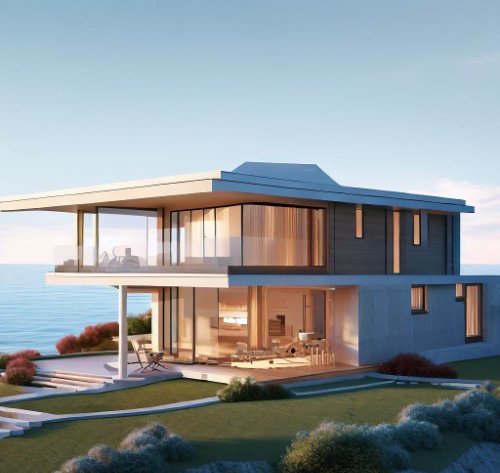Unlocking the Benefits of 3D Visualization
In today's digital era, 3D visualization has become an indispensable tool across various industries, revolutionizing the way we perceive and interact with virtual representations of objects and spaces. From architecture and interior design to product development and marketing, 3D visualization offers a wide array of benefits that enhance communication, streamline workflows, and elevate the overall user experience. In this article, we will explore the key advantages of 3D visualization and its applications in different sectors.
Enhanced Communication and Presentation

- Realistic and Immersive Experience: With 3D visualization, users can experience a virtual environment that closely resembles the real world. High-quality visuals, accurate lighting, and realistic textures create an immersive experience that enables stakeholders to visualize designs, products, or spaces with exceptional detail and precision.
- Better Conceptualization and Understanding: 3D visualization allows concepts, designs, and ideas to be communicated more effectively. Instead of relying on 2D drawings or blueprints, stakeholders can interact with 3D models and gain a comprehensive understanding of the proposed project. This leads to fewer misunderstandings, improved collaboration, and informed decision-making.
- Multiple Perspectives and Viewpoints: With 3D visualization, stakeholders can explore a design or space from various angles, zoom in and out, and even walk through virtual environments. This capability provides a holistic view and helps stakeholders analyze and evaluate the design from different perspectives, ensuring that every detail is considered before implementation.
- Customization and Iteration: 3D visualization enables quick and seamless customization of designs. Changes can be easily made to the virtual model, allowing stakeholders to visualize different options, materials, or configurations. This iterative process facilitates efficient design refinements, reducing the need for costly physical prototypes or rework.
Applications and Advantages
- Architecture and Real Estate: In the field of architecture and real estate, 3D visualization plays a crucial role in presenting designs to clients, investors, and regulatory authorities. It enables architects and designers to showcase their vision, demonstrate spatial relationships, and simulate lighting conditions. Additionally, prospective buyers can explore virtual tours of properties, providing an immersive and interactive experience that enhances decision-making.
- Product Development and Prototyping: 3D visualization revolutionizes the product development process. It allows designers to create virtual prototypes, test different iterations, and identify design flaws before production. This results in cost savings, faster time to market, and the ability to make informed design decisions.
- Marketing and Advertising: 3D visualization is an effective marketing tool for showcasing products, concepts, or spaces. By creating photorealistic visuals, immersive virtual tours, or interactive product demonstrations, companies can captivate their target audience and differentiate themselves from competitors. This leads to increased brand engagement, customer interest, and ultimately, sales.
- Interior Design: 3D visualization is invaluable in the field of interior design. It enables designers to create realistic renderings of spaces, experiment with different furniture arrangements, and visualize color schemes and materials. This helps clients make informed decisions about their interior design projects and ensures that the final result meets their expectations.

FAQ
Q: How long does it take to create a 3D visualization?
A: The time required to create a 3D visualization depends on the complexity of the project, the level of detail required, and the availability of the necessary assets. Simple visualizations may take a few days, while more intricate projects may require several weeks. It is best to discuss timelines and project requirements with the visualization team to get an accurate estimate.
Q: Can 3D visualization be used for virtual reality (VR) experiences?
A: Yes, 3D visualization can be utilized in virtual reality experiences. By leveraging VR technology, users can immerse themselves in virtual environments and interact with 3D models in a more immersive and realistic way. This opens up new possibilities for architectural walkthroughs, virtual showrooms, and interactive training simulations.
Q: Are there any limitations to 3D visualization?
A: While 3D visualization offers numerous benefits, there are a few limitations to consider. Some challenges include the initial cost of creating high-quality 3D models, the need for skilled professionals to develop and render the visualizations, and potential hardware requirements for viewing complex 3D environments. Additionally, the level of realism achieved in 3D visualizations may still have slight discrepancies compared to real-world experiences.
Q: Can 3D visualization be integrated into existing workflows?
A: Absolutely. 3D visualization can seamlessly integrate into existing workflows across various industries. Designers, architects, and engineers can incorporate 3D visualizations into their design processes, facilitating better communication with clients and stakeholders. In manufacturing, 3D visualizations can be used to streamline product development and prototyping. Furthermore, marketing and sales teams can leverage 3D visualizations to enhance their promotional efforts.
Q: How can I get started with 3D visualization for my business?
A: To get started with 3D visualization for your business, consider partnering with experienced professionals or agencies specializing in 3D visualization services. They can guide you through the process, understand your specific requirements, and create compelling visualizations tailored to your needs. Begin by exploring our 3D Visualizations page for examples and to learn more about our services.
In conclusion, 3D visualization offers numerous benefits across industries, including enhanced communication and presentation, better conceptualization and understanding, multiple perspectives and viewpoints, and customization and iteration. From architecture and real estate to product development and interior design, the applications of 3D visualization are extensive and impactful. By embracing this technology, businesses can elevate their communication strategies, streamline workflows, and engage stakeholders in more immersive and interactive experiences.
To learn more about our 3D visualization services and explore our portfolio, please visit our 3D Visualizations page. For other web development and digital solutions, visit our Services page. If you have any inquiries or would like to discuss a potential project, feel free to reach out to us via our Contact page.
Blog Author: Marek Eller
Post Date: May 16, 2023
Categories: 3D visualizationsFeatured

